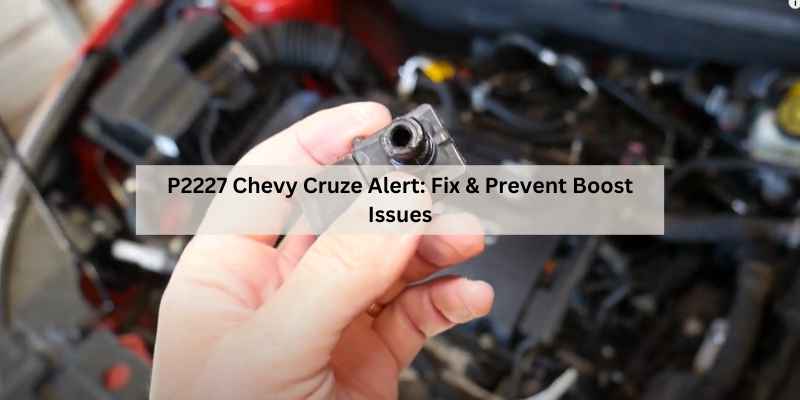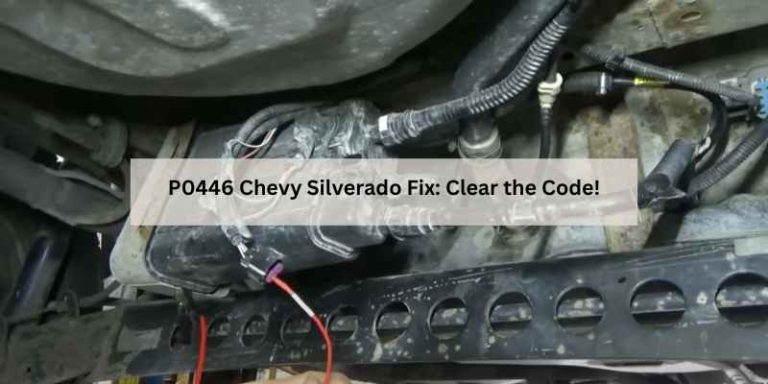P2227 Chevy Cruze Alert: Fix & Prevent Boost Issues
P2227 in a Chevy Cruze indicates an issue with the Turbocharger/Supercharger Boost Sensor A Circuit Low and the Barometric Pressure Circuit Range Performance. This error suggests that the voltage readings from the barometric pressure sensor are outside expected parameters.
The P2227 trouble code can lead to significant performance issues in your Chevy Cruze if not addressed promptly. It usually points to a malfunction in the turbocharger or supercharger boost sensor, which plays a crucial role in the engine’s performance.
A faulty barometric pressure sensor can also be the culprit, affecting your vehicle’s ability to adjust to changing atmospheric conditions. Ignoring this code can result in poor fuel efficiency, decreased power, and potential damage to the engine. Regular diagnostic checks help maintain optimal vehicle health and ensure a smoother driving experience.
Introduction To P2227 Alert In Chevy Cruze
The P2227 code in a Chevy Cruze indicates an issue with the barometric pressure sensor. This sensor is crucial for monitoring the air pressure in the engine’s intake manifold. A malfunction can lead to poor engine performance and reduced fuel efficiency.
Common symptoms of a P2227 alert include:
- Check engine light illuminated
- Decreased engine performance
- Rough idling or stalling
- Poor fuel economy
Addressing these symptoms promptly helps prevent further engine damage. Regular maintenance ensures that the barometric pressure sensor functions correctly.
Identifying The Root Causes
The barometric pressure sensor plays a crucial role in your Chevy Cruze. It measures the atmospheric pressure and helps the engine control module (ECM) adjust the air-fuel mixture. A malfunctioning sensor can lead to poor engine performance. It may cause rough idling or decreased fuel efficiency.
A faulty boost sensor impacts performance significantly. It can trigger the P2227 error code. This code indicates an issue with the boost sensor circuit. When this happens, the engine may not produce enough power. Drivers may experience sluggish acceleration and increased emissions.
| Issue | Effects |
|---|---|
| Faulty Barometric Pressure Sensor | Poor engine performance, rough idling |
| Faulty Boost Sensor | Sluggish acceleration, increased emissions |
Locating The Barometric Pressure Sensor
To locate the Barometric Pressure Sensor on a Chevy Cruze, follow these steps. First, open the hood of your vehicle. Next, look toward the center of the engine bay. The sensor is usually positioned behind the intake manifold, just below the throttle body.
Different models might have variations in sensor location. Here is a quick overview:
| Model Year | Sensor Location |
|---|---|
| 2011-2015 | Behind the intake manifold |
| 2016-2019 | Near the throttle body |
Always consult your owner’s manual for specific details. This ensures you find the sensor quickly and accurately.
Diagnostics And Error Codes
Reading the P2227 code involves checking the barometric pressure sensor. This code signals an issue with the Turbocharger/Supercharger Boost Sensor. Understanding the parameters set by the engine control module (ECM) is crucial. Incorrect readings can lead to poor engine performance.
To interpret the P2227 code accurately, gather the following tools:
- OBD-II scanner for code reading
- Multimeter to measure voltage and resistance
- Wrench set for sensor removal
- Repair manual for reference
Using these tools helps identify the root cause of the error. Always check the sensor connections and wires for damage. A thorough inspection ensures accurate diagnostics.
Effective Fixes For P2227 Issues
The Chevy Cruze’s barometric pressure sensor is crucial for accurate readings. It helps the engine control module (ECM) adjust fuel and air mixture. To replace the sensor, locate it behind the intake manifold. This is usually below the throttle body. Disconnect the battery, remove the old sensor, and install the new one. Reconnect everything carefully.
Troubleshooting the boost sensor circuit is essential for fixing P2227 issues. First, check the wiring for damage or corrosion. Inspect the connectors for loose or broken parts. Use a multimeter to test the voltage readings. Ensure they match the manufacturer’s specifications. If problems persist, consider replacing the boost sensor.
Prevention Strategies
Regular maintenance is key for your Chevy Cruze. Check the engine oil and replace it regularly. This keeps the engine running smoothly. Inspect the air filter often. A clean filter allows for better airflow.
Ensure the spark plugs are in good condition. Replace them if they are worn out. This helps maintain engine performance. Also, check the boost sensor connections. Loose or corroded wires can cause issues.
Consider upgrading to a high-quality MAP sensor. This can improve accuracy and response. Using a premium fuel can also enhance performance. These small changes can prevent future boost issues.
Navigating Warranty And Repair Services
Understanding your Chevy Cruze’s warranty is essential for maintaining your vehicle. Each warranty has specific coverage limits. Most warranties cover major components like the engine and transmission. Keep your warranty documents in a safe place for easy reference.
Finding authorized repair centers ensures quality service. Authorized centers have trained technicians familiar with Chevy Cruze models. They use genuine parts, which can enhance your car’s performance. Always check for customer reviews before choosing a repair center.
To make the most of your warranty, keep records of all maintenance. Schedule regular check-ups to avoid potential issues. If a problem arises, contact customer service for guidance. They can help you navigate warranty claims effectively.
Community And Expert Insights
Many forums provide insights on P2227 issues in Chevy Cruzes. Owners often share their experiences regarding the MAP sensor and barometric pressure sensor. These discussions help identify common problems and solutions.
Professional advice emphasizes checking the MAP sensor’s location, which is behind the intake manifold. It’s important to regularly inspect the wiring and connections. A faulty sensor can lead to poor performance.
Boost issues can arise from several factors. Regular maintenance, including cleaning and calibrating sensors, can prevent these issues. Always seek expert guidance when troubleshooting to avoid further damage.
Frequently Asked Questions
What Does Code P2227 Mean In Chevy Cruze?
Code P2227 in a Chevy Cruze indicates an issue with the Barometric Pressure Sensor circuit. It usually means the sensor is providing readings outside the expected range. This problem can affect engine performance and may require immediate attention to avoid further damage.
What Is The Code P2227 00 Barometric Pressure Baro Sensor Performance?
The P2227 00 code indicates a performance issue with the barometric pressure sensor. This typically means the sensor’s readings don’t align with the expected atmospheric conditions. It’s essential to diagnose and repair the sensor or its connections to ensure proper engine performance.
Where Is The Barometric Pressure Sensor On A 2014 Chevy Cruze?
The barometric pressure sensor on a 2014 Chevy Cruze is located behind the intake manifold, beneath the throttle body. Open the hood and look toward the center of the engine bay for easy access.
Where Is The Ambient Air Temperature Sensor On A Chevy Cruze?
The ambient air temperature sensor on a Chevy Cruze is typically located in the front grille area. It measures outside air temperature for the climate control system. Check near the front bumper or under the hood for easy access.
Conclusion
Understanding the P2227 code for the Chevy Cruze is essential for maintaining your vehicle’s performance. This code indicates issues with the barometric pressure sensor. Addressing these problems promptly can prevent further damage and ensure a smoother driving experience. Stay proactive with your vehicle’s maintenance to keep it running efficiently.







